Sainsbury's Business Management: Industry Trends & Strategy Report
VerifiedAdded on 2023/06/14
|11
|3378
|437
Report
AI Summary
This report provides a comprehensive analysis of Sainsbury's business context and management strategies. It examines the external environment using models like TAM, SAM, SOM, and the Business Cycle Model, highlighting trends such as supply chain challenges and competitive pressures. The internal environment is analyzed using the McKinsey 7s Model and VRIO framework, focusing on Sainsbury's strengths and competitive advantages. The report assesses operational management through TQM and Six Sigma, and explores change management using Kotter's theory. Furthermore, it applies Edward Freeman's stakeholder theory to analyze Sainsbury's relationships with employees, customers, and suppliers. The report concludes with an industry trend analysis and recommendations for business strategy using the PDCA approach, aiming to enhance Sainsbury's growth and resilience. Desklib offers a wealth of similar solved assignments and resources for students.
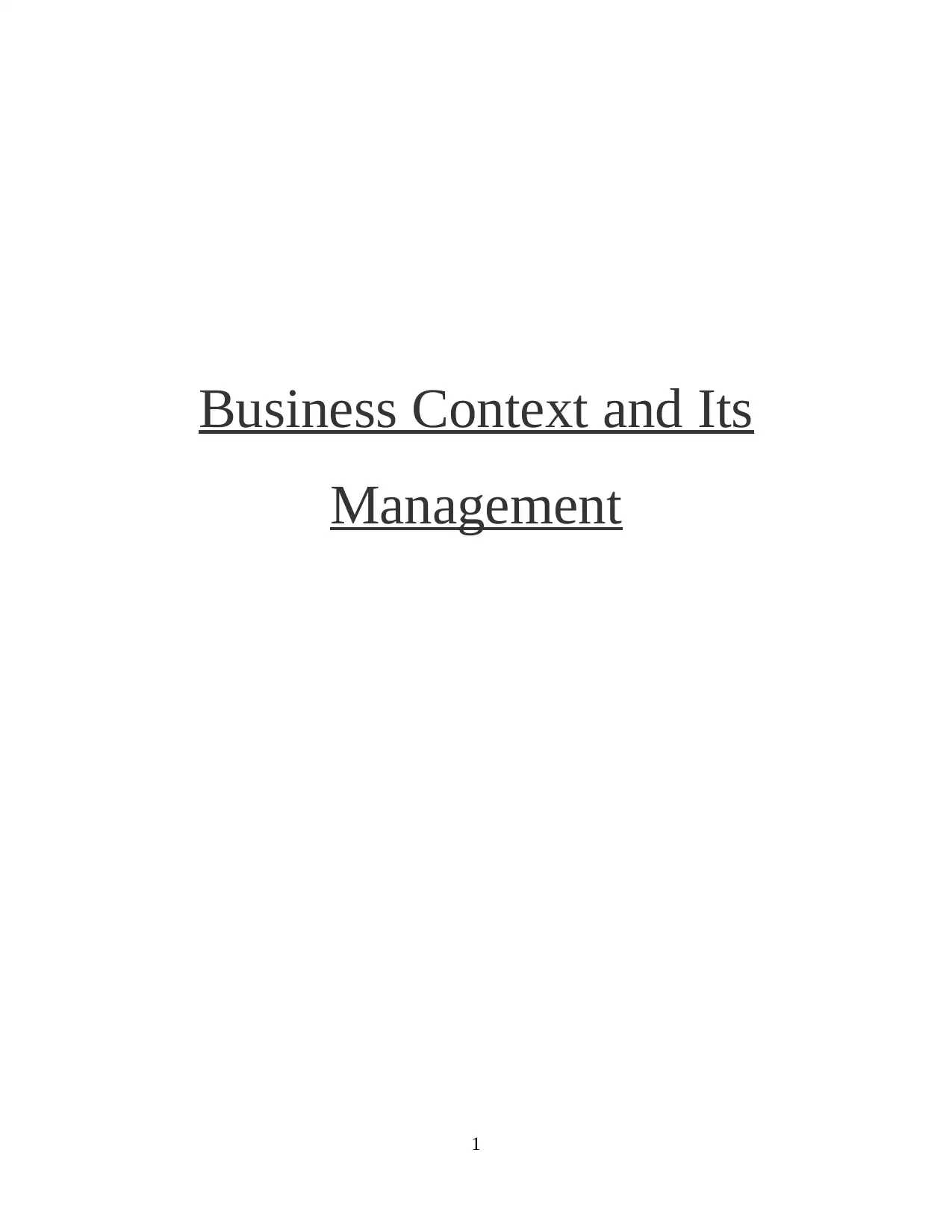
Business Context and Its
Management
1
Management
1
Paraphrase This Document
Need a fresh take? Get an instant paraphrase of this document with our AI Paraphraser
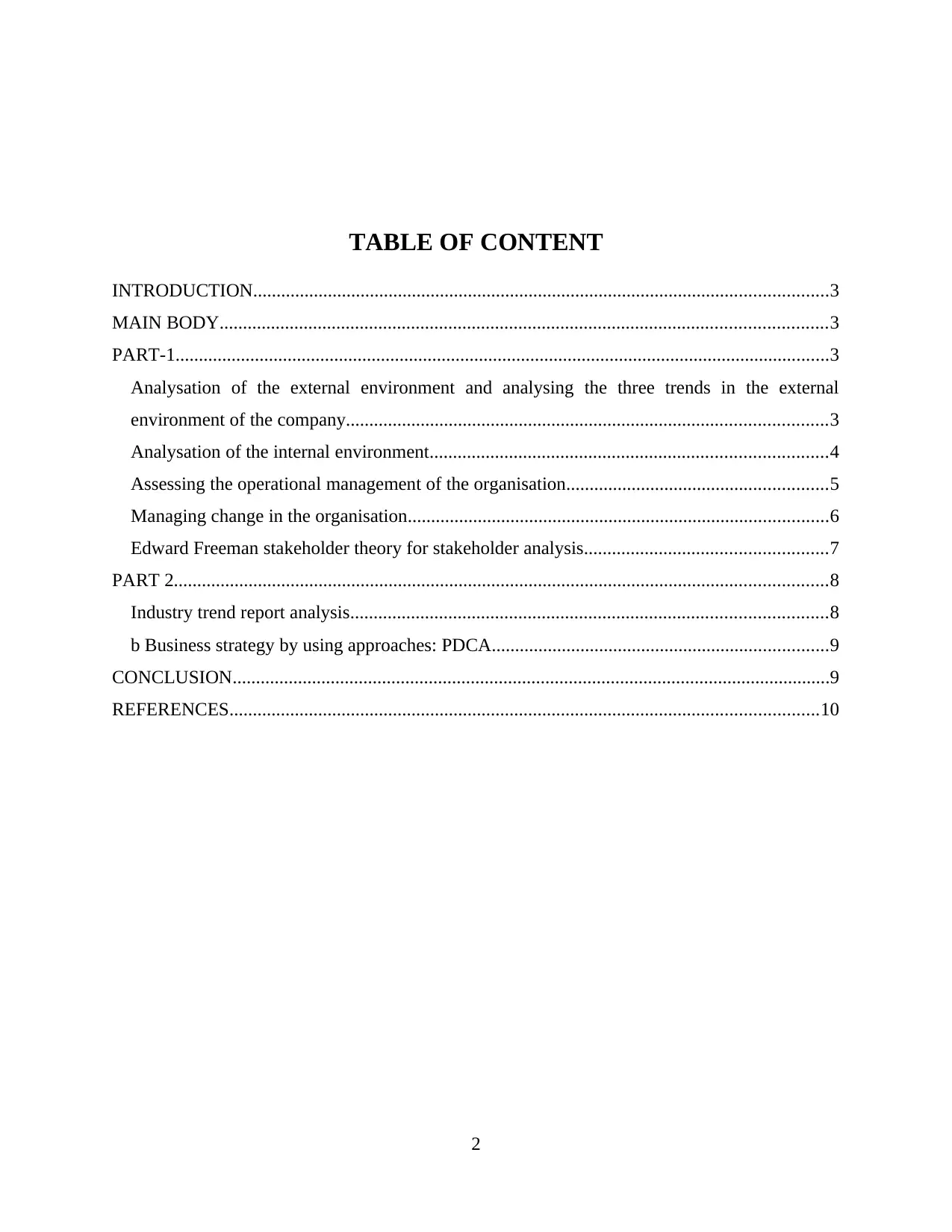
TABLE OF CONTENT
INTRODUCTION...........................................................................................................................3
MAIN BODY..................................................................................................................................3
PART-1............................................................................................................................................3
Analysation of the external environment and analysing the three trends in the external
environment of the company.......................................................................................................3
Analysation of the internal environment.....................................................................................4
Assessing the operational management of the organisation........................................................5
Managing change in the organisation..........................................................................................6
Edward Freeman stakeholder theory for stakeholder analysis....................................................7
PART 2............................................................................................................................................8
Industry trend report analysis......................................................................................................8
b Business strategy by using approaches: PDCA........................................................................9
CONCLUSION................................................................................................................................9
REFERENCES..............................................................................................................................10
2
INTRODUCTION...........................................................................................................................3
MAIN BODY..................................................................................................................................3
PART-1............................................................................................................................................3
Analysation of the external environment and analysing the three trends in the external
environment of the company.......................................................................................................3
Analysation of the internal environment.....................................................................................4
Assessing the operational management of the organisation........................................................5
Managing change in the organisation..........................................................................................6
Edward Freeman stakeholder theory for stakeholder analysis....................................................7
PART 2............................................................................................................................................8
Industry trend report analysis......................................................................................................8
b Business strategy by using approaches: PDCA........................................................................9
CONCLUSION................................................................................................................................9
REFERENCES..............................................................................................................................10
2

INTRODUCTION
Business context is the proper understanding of the aspects that impacts the business
from the various perspectives. The proper business context management helps in understanding
the factors that can affect the growth and success of the business. It includes the decision-making
of the company after analysation of the aspects that affects business. This report will illustrate
the industry trends of the Sainsbury. Along with this, the report will provide the
recommendations to the firm on the basis of the analysation that can lead to increase the growth
of the company and further helps in dealing with the drastic situations.
MAIN BODY
PART-1
Analysation of the external environment and analysing the three trends in the external
environment of the company
External environment is consists of the various industrial trends that can leads to provide the
impact on the business in the positive and negative manner. Here is the external analysation of
the Sainsbury:
TAM, SAM, SOM- This refers to the total available market, Serviceable available market
and share of market. It has been found from various studies that, during the COVID the demand
for the retail goods was high but the supply was not meeting the demand. Hence, the TAM, SAM
and SOM of the Sainsbury got affected (Tronvoll, Barile and Caputo, 2018). The company has
the captured market share. In order to maintain the captured market share it is important to
maintain the demand of the customers. However, this management of company got affected.
Business Cycle Model
This model shows the progress of the business throughout the time. Here is the business cycle
model of Sainsbury:
Launch- In the launch phase, Sainsbury has focused in launching the large number of
products in retail goods. Also, the company has assured the affordable price to the customers.
Growth- In this phase, the company has experienced the high success as the firm assured
the large number of products in the effective prices. As a result, rapid sales has been experienced
by the company.
3
Business context is the proper understanding of the aspects that impacts the business
from the various perspectives. The proper business context management helps in understanding
the factors that can affect the growth and success of the business. It includes the decision-making
of the company after analysation of the aspects that affects business. This report will illustrate
the industry trends of the Sainsbury. Along with this, the report will provide the
recommendations to the firm on the basis of the analysation that can lead to increase the growth
of the company and further helps in dealing with the drastic situations.
MAIN BODY
PART-1
Analysation of the external environment and analysing the three trends in the external
environment of the company
External environment is consists of the various industrial trends that can leads to provide the
impact on the business in the positive and negative manner. Here is the external analysation of
the Sainsbury:
TAM, SAM, SOM- This refers to the total available market, Serviceable available market
and share of market. It has been found from various studies that, during the COVID the demand
for the retail goods was high but the supply was not meeting the demand. Hence, the TAM, SAM
and SOM of the Sainsbury got affected (Tronvoll, Barile and Caputo, 2018). The company has
the captured market share. In order to maintain the captured market share it is important to
maintain the demand of the customers. However, this management of company got affected.
Business Cycle Model
This model shows the progress of the business throughout the time. Here is the business cycle
model of Sainsbury:
Launch- In the launch phase, Sainsbury has focused in launching the large number of
products in retail goods. Also, the company has assured the affordable price to the customers.
Growth- In this phase, the company has experienced the high success as the firm assured
the large number of products in the effective prices. As a result, rapid sales has been experienced
by the company.
3
⊘ This is a preview!⊘
Do you want full access?
Subscribe today to unlock all pages.

Trusted by 1+ million students worldwide
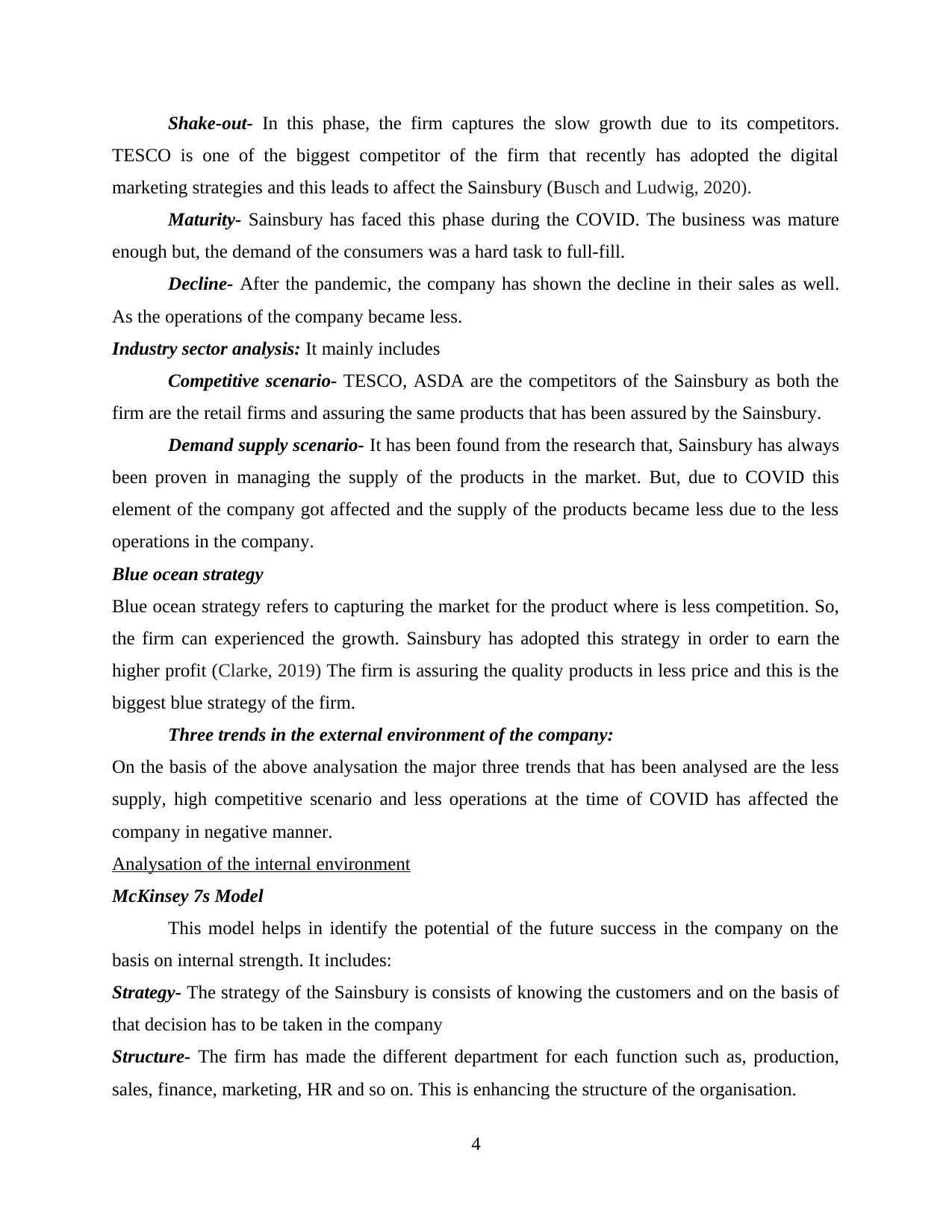
Shake-out- In this phase, the firm captures the slow growth due to its competitors.
TESCO is one of the biggest competitor of the firm that recently has adopted the digital
marketing strategies and this leads to affect the Sainsbury (Busch and Ludwig, 2020).
Maturity- Sainsbury has faced this phase during the COVID. The business was mature
enough but, the demand of the consumers was a hard task to full-fill.
Decline- After the pandemic, the company has shown the decline in their sales as well.
As the operations of the company became less.
Industry sector analysis: It mainly includes
Competitive scenario- TESCO, ASDA are the competitors of the Sainsbury as both the
firm are the retail firms and assuring the same products that has been assured by the Sainsbury.
Demand supply scenario- It has been found from the research that, Sainsbury has always
been proven in managing the supply of the products in the market. But, due to COVID this
element of the company got affected and the supply of the products became less due to the less
operations in the company.
Blue ocean strategy
Blue ocean strategy refers to capturing the market for the product where is less competition. So,
the firm can experienced the growth. Sainsbury has adopted this strategy in order to earn the
higher profit (Clarke, 2019) The firm is assuring the quality products in less price and this is the
biggest blue strategy of the firm.
Three trends in the external environment of the company:
On the basis of the above analysation the major three trends that has been analysed are the less
supply, high competitive scenario and less operations at the time of COVID has affected the
company in negative manner.
Analysation of the internal environment
McKinsey 7s Model
This model helps in identify the potential of the future success in the company on the
basis on internal strength. It includes:
Strategy- The strategy of the Sainsbury is consists of knowing the customers and on the basis of
that decision has to be taken in the company
Structure- The firm has made the different department for each function such as, production,
sales, finance, marketing, HR and so on. This is enhancing the structure of the organisation.
4
TESCO is one of the biggest competitor of the firm that recently has adopted the digital
marketing strategies and this leads to affect the Sainsbury (Busch and Ludwig, 2020).
Maturity- Sainsbury has faced this phase during the COVID. The business was mature
enough but, the demand of the consumers was a hard task to full-fill.
Decline- After the pandemic, the company has shown the decline in their sales as well.
As the operations of the company became less.
Industry sector analysis: It mainly includes
Competitive scenario- TESCO, ASDA are the competitors of the Sainsbury as both the
firm are the retail firms and assuring the same products that has been assured by the Sainsbury.
Demand supply scenario- It has been found from the research that, Sainsbury has always
been proven in managing the supply of the products in the market. But, due to COVID this
element of the company got affected and the supply of the products became less due to the less
operations in the company.
Blue ocean strategy
Blue ocean strategy refers to capturing the market for the product where is less competition. So,
the firm can experienced the growth. Sainsbury has adopted this strategy in order to earn the
higher profit (Clarke, 2019) The firm is assuring the quality products in less price and this is the
biggest blue strategy of the firm.
Three trends in the external environment of the company:
On the basis of the above analysation the major three trends that has been analysed are the less
supply, high competitive scenario and less operations at the time of COVID has affected the
company in negative manner.
Analysation of the internal environment
McKinsey 7s Model
This model helps in identify the potential of the future success in the company on the
basis on internal strength. It includes:
Strategy- The strategy of the Sainsbury is consists of knowing the customers and on the basis of
that decision has to be taken in the company
Structure- The firm has made the different department for each function such as, production,
sales, finance, marketing, HR and so on. This is enhancing the structure of the organisation.
4
Paraphrase This Document
Need a fresh take? Get an instant paraphrase of this document with our AI Paraphraser

System- This involves the daily procedure of performing the job in the company. Sainsbury has
created the system in which each subordinate immediately report to the superior after the
completion of the task (Barattieri, Cacciatore and Ghironi, 2021).
Shared-values- Sainsbury has adopted the effective organisational culture in which the values
has been ensured to every employee
Style- The company has adopted the participative leadership style that providing the
opportunities to the employees in terms of sharing their opinions as well.
Staff- It has been found from various studies that the company has adopted the effective talent
management strategies in order to appoint the effective staff.
Skills- Sainsbury organizes the training and development programmes in order to enhance the
skills of the employees.
VRIO Framework
This model is used to analyse internal environment of the business that helps the
organisation in order to identify the advantages and the resources that assures the competitive
edge.
Value- Sainsbury is assuring the higher value to the customers by charging the less prices of the
product. Also, the variety in products has been assured to the customers.
Rare- The unique capability of the Sainsbury is that the company focuses on understanding their
consumers. And on the basis of that the decision has been taken by the firm.
Inimitable- The company focuses on enhancing the physical and human resources in the
company. As the growth of the company depends upon this.
Organized- The company has adopted the consumer-oriented structure in order to grab the
competitive advantage (Miethlich and Oldenburg, 2019).
On the basis of the above analysation it can clearly state that, Sainsbury focuses on their
internal capabilities in order to enhance the effectiveness of the business and for taking the
competitive advantage.
Assessing the operational management of the organisation
Operational management refers to the process of converting the input into the final output that
has to be delivered to the customers. This management of the company reflects the effectiveness
of the firm as the final products has been under this. Sainsbury has been proven effective enough
5
created the system in which each subordinate immediately report to the superior after the
completion of the task (Barattieri, Cacciatore and Ghironi, 2021).
Shared-values- Sainsbury has adopted the effective organisational culture in which the values
has been ensured to every employee
Style- The company has adopted the participative leadership style that providing the
opportunities to the employees in terms of sharing their opinions as well.
Staff- It has been found from various studies that the company has adopted the effective talent
management strategies in order to appoint the effective staff.
Skills- Sainsbury organizes the training and development programmes in order to enhance the
skills of the employees.
VRIO Framework
This model is used to analyse internal environment of the business that helps the
organisation in order to identify the advantages and the resources that assures the competitive
edge.
Value- Sainsbury is assuring the higher value to the customers by charging the less prices of the
product. Also, the variety in products has been assured to the customers.
Rare- The unique capability of the Sainsbury is that the company focuses on understanding their
consumers. And on the basis of that the decision has been taken by the firm.
Inimitable- The company focuses on enhancing the physical and human resources in the
company. As the growth of the company depends upon this.
Organized- The company has adopted the consumer-oriented structure in order to grab the
competitive advantage (Miethlich and Oldenburg, 2019).
On the basis of the above analysation it can clearly state that, Sainsbury focuses on their
internal capabilities in order to enhance the effectiveness of the business and for taking the
competitive advantage.
Assessing the operational management of the organisation
Operational management refers to the process of converting the input into the final output that
has to be delivered to the customers. This management of the company reflects the effectiveness
of the firm as the final products has been under this. Sainsbury has been proven effective enough
5
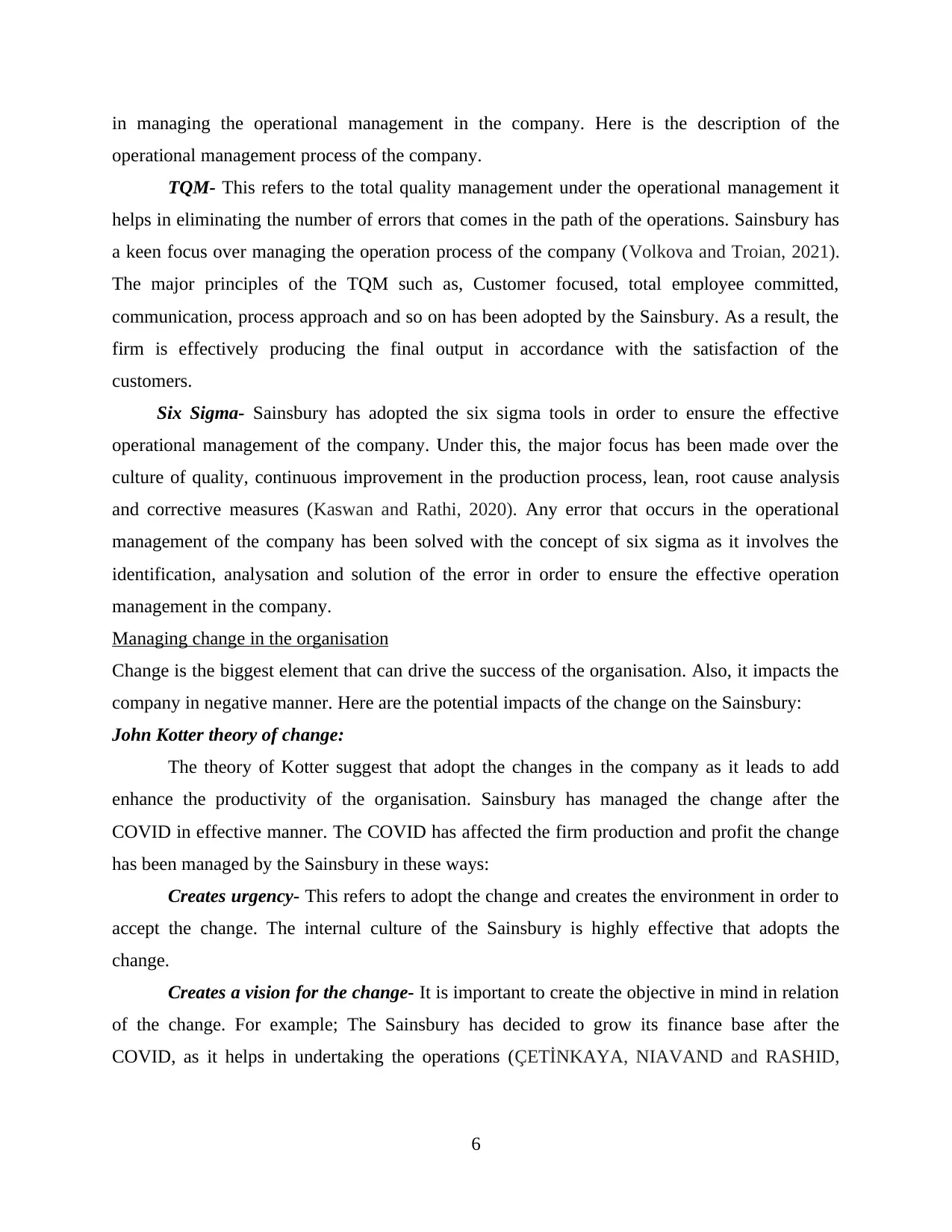
in managing the operational management in the company. Here is the description of the
operational management process of the company.
TQM- This refers to the total quality management under the operational management it
helps in eliminating the number of errors that comes in the path of the operations. Sainsbury has
a keen focus over managing the operation process of the company (Volkova and Troian, 2021).
The major principles of the TQM such as, Customer focused, total employee committed,
communication, process approach and so on has been adopted by the Sainsbury. As a result, the
firm is effectively producing the final output in accordance with the satisfaction of the
customers.
Six Sigma- Sainsbury has adopted the six sigma tools in order to ensure the effective
operational management of the company. Under this, the major focus has been made over the
culture of quality, continuous improvement in the production process, lean, root cause analysis
and corrective measures (Kaswan and Rathi, 2020). Any error that occurs in the operational
management of the company has been solved with the concept of six sigma as it involves the
identification, analysation and solution of the error in order to ensure the effective operation
management in the company.
Managing change in the organisation
Change is the biggest element that can drive the success of the organisation. Also, it impacts the
company in negative manner. Here are the potential impacts of the change on the Sainsbury:
John Kotter theory of change:
The theory of Kotter suggest that adopt the changes in the company as it leads to add
enhance the productivity of the organisation. Sainsbury has managed the change after the
COVID in effective manner. The COVID has affected the firm production and profit the change
has been managed by the Sainsbury in these ways:
Creates urgency- This refers to adopt the change and creates the environment in order to
accept the change. The internal culture of the Sainsbury is highly effective that adopts the
change.
Creates a vision for the change- It is important to create the objective in mind in relation
of the change. For example; The Sainsbury has decided to grow its finance base after the
COVID, as it helps in undertaking the operations (ÇETİNKAYA, NIAVAND and RASHID,
6
operational management process of the company.
TQM- This refers to the total quality management under the operational management it
helps in eliminating the number of errors that comes in the path of the operations. Sainsbury has
a keen focus over managing the operation process of the company (Volkova and Troian, 2021).
The major principles of the TQM such as, Customer focused, total employee committed,
communication, process approach and so on has been adopted by the Sainsbury. As a result, the
firm is effectively producing the final output in accordance with the satisfaction of the
customers.
Six Sigma- Sainsbury has adopted the six sigma tools in order to ensure the effective
operational management of the company. Under this, the major focus has been made over the
culture of quality, continuous improvement in the production process, lean, root cause analysis
and corrective measures (Kaswan and Rathi, 2020). Any error that occurs in the operational
management of the company has been solved with the concept of six sigma as it involves the
identification, analysation and solution of the error in order to ensure the effective operation
management in the company.
Managing change in the organisation
Change is the biggest element that can drive the success of the organisation. Also, it impacts the
company in negative manner. Here are the potential impacts of the change on the Sainsbury:
John Kotter theory of change:
The theory of Kotter suggest that adopt the changes in the company as it leads to add
enhance the productivity of the organisation. Sainsbury has managed the change after the
COVID in effective manner. The COVID has affected the firm production and profit the change
has been managed by the Sainsbury in these ways:
Creates urgency- This refers to adopt the change and creates the environment in order to
accept the change. The internal culture of the Sainsbury is highly effective that adopts the
change.
Creates a vision for the change- It is important to create the objective in mind in relation
of the change. For example; The Sainsbury has decided to grow its finance base after the
COVID, as it helps in undertaking the operations (ÇETİNKAYA, NIAVAND and RASHID,
6
⊘ This is a preview!⊘
Do you want full access?
Subscribe today to unlock all pages.

Trusted by 1+ million students worldwide
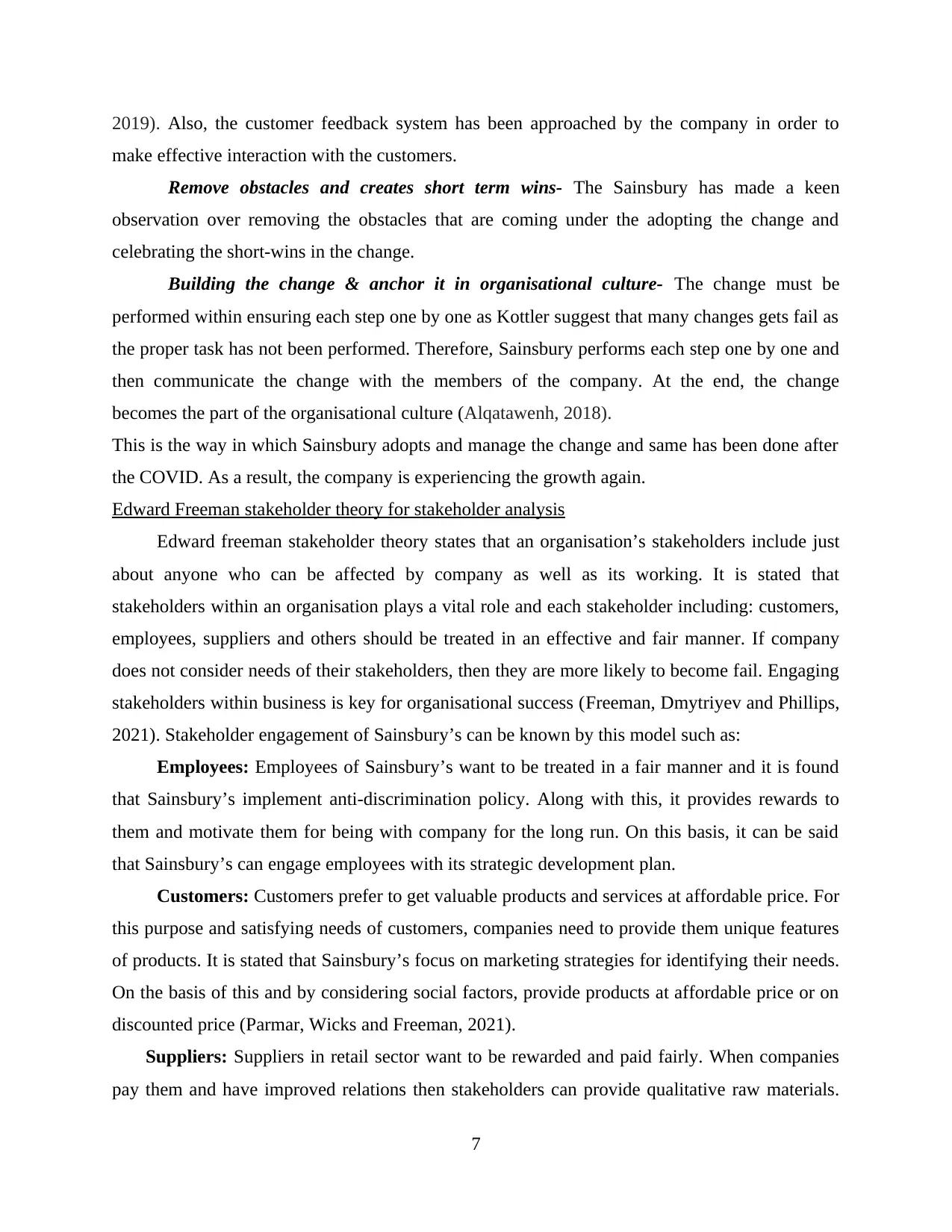
2019). Also, the customer feedback system has been approached by the company in order to
make effective interaction with the customers.
Remove obstacles and creates short term wins- The Sainsbury has made a keen
observation over removing the obstacles that are coming under the adopting the change and
celebrating the short-wins in the change.
Building the change & anchor it in organisational culture- The change must be
performed within ensuring each step one by one as Kottler suggest that many changes gets fail as
the proper task has not been performed. Therefore, Sainsbury performs each step one by one and
then communicate the change with the members of the company. At the end, the change
becomes the part of the organisational culture (Alqatawenh, 2018).
This is the way in which Sainsbury adopts and manage the change and same has been done after
the COVID. As a result, the company is experiencing the growth again.
Edward Freeman stakeholder theory for stakeholder analysis
Edward freeman stakeholder theory states that an organisation’s stakeholders include just
about anyone who can be affected by company as well as its working. It is stated that
stakeholders within an organisation plays a vital role and each stakeholder including: customers,
employees, suppliers and others should be treated in an effective and fair manner. If company
does not consider needs of their stakeholders, then they are more likely to become fail. Engaging
stakeholders within business is key for organisational success (Freeman, Dmytriyev and Phillips,
2021). Stakeholder engagement of Sainsbury’s can be known by this model such as:
Employees: Employees of Sainsbury’s want to be treated in a fair manner and it is found
that Sainsbury’s implement anti-discrimination policy. Along with this, it provides rewards to
them and motivate them for being with company for the long run. On this basis, it can be said
that Sainsbury’s can engage employees with its strategic development plan.
Customers: Customers prefer to get valuable products and services at affordable price. For
this purpose and satisfying needs of customers, companies need to provide them unique features
of products. It is stated that Sainsbury’s focus on marketing strategies for identifying their needs.
On the basis of this and by considering social factors, provide products at affordable price or on
discounted price (Parmar, Wicks and Freeman, 2021).
Suppliers: Suppliers in retail sector want to be rewarded and paid fairly. When companies
pay them and have improved relations then stakeholders can provide qualitative raw materials.
7
make effective interaction with the customers.
Remove obstacles and creates short term wins- The Sainsbury has made a keen
observation over removing the obstacles that are coming under the adopting the change and
celebrating the short-wins in the change.
Building the change & anchor it in organisational culture- The change must be
performed within ensuring each step one by one as Kottler suggest that many changes gets fail as
the proper task has not been performed. Therefore, Sainsbury performs each step one by one and
then communicate the change with the members of the company. At the end, the change
becomes the part of the organisational culture (Alqatawenh, 2018).
This is the way in which Sainsbury adopts and manage the change and same has been done after
the COVID. As a result, the company is experiencing the growth again.
Edward Freeman stakeholder theory for stakeholder analysis
Edward freeman stakeholder theory states that an organisation’s stakeholders include just
about anyone who can be affected by company as well as its working. It is stated that
stakeholders within an organisation plays a vital role and each stakeholder including: customers,
employees, suppliers and others should be treated in an effective and fair manner. If company
does not consider needs of their stakeholders, then they are more likely to become fail. Engaging
stakeholders within business is key for organisational success (Freeman, Dmytriyev and Phillips,
2021). Stakeholder engagement of Sainsbury’s can be known by this model such as:
Employees: Employees of Sainsbury’s want to be treated in a fair manner and it is found
that Sainsbury’s implement anti-discrimination policy. Along with this, it provides rewards to
them and motivate them for being with company for the long run. On this basis, it can be said
that Sainsbury’s can engage employees with its strategic development plan.
Customers: Customers prefer to get valuable products and services at affordable price. For
this purpose and satisfying needs of customers, companies need to provide them unique features
of products. It is stated that Sainsbury’s focus on marketing strategies for identifying their needs.
On the basis of this and by considering social factors, provide products at affordable price or on
discounted price (Parmar, Wicks and Freeman, 2021).
Suppliers: Suppliers in retail sector want to be rewarded and paid fairly. When companies
pay them and have improved relations then stakeholders can provide qualitative raw materials.
7
Paraphrase This Document
Need a fresh take? Get an instant paraphrase of this document with our AI Paraphraser
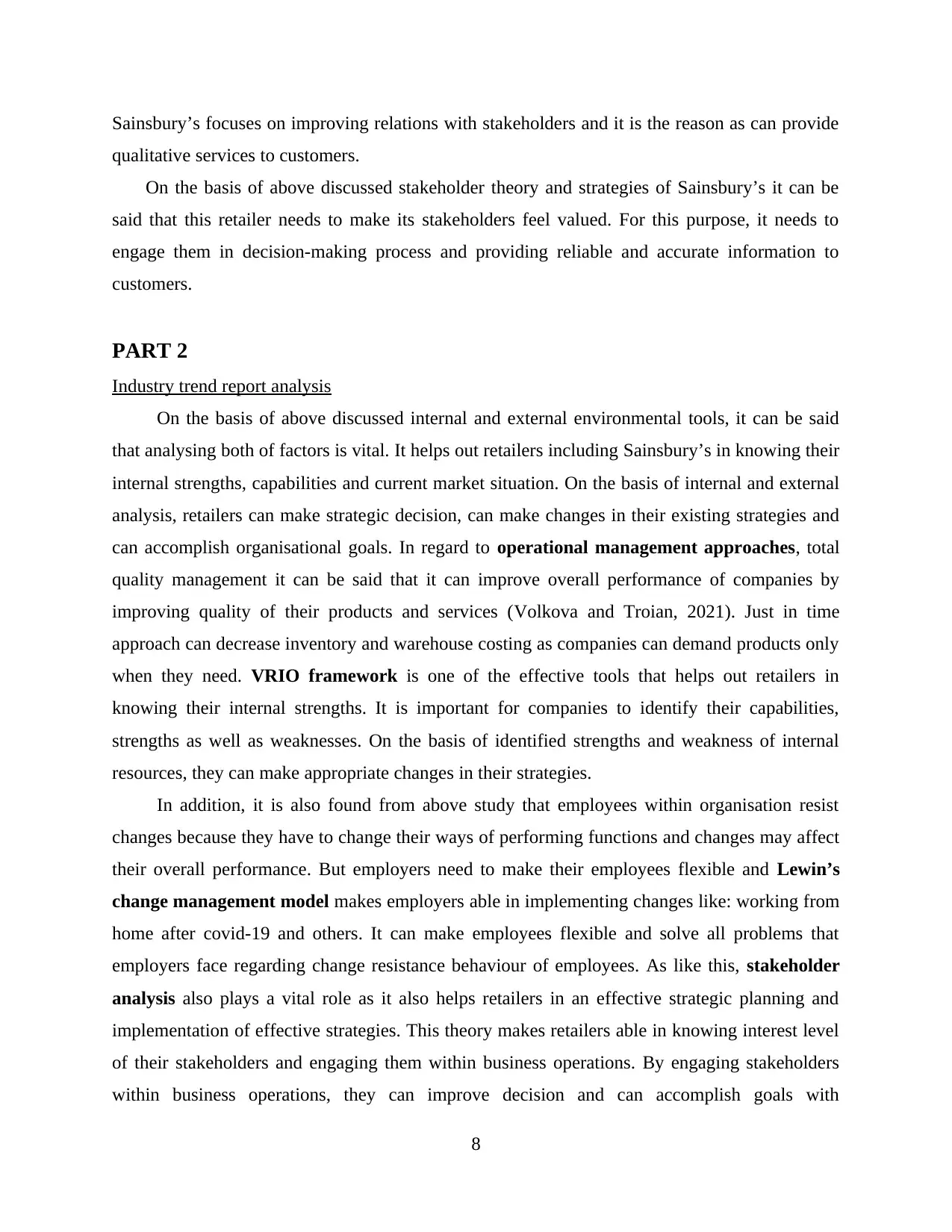
Sainsbury’s focuses on improving relations with stakeholders and it is the reason as can provide
qualitative services to customers.
On the basis of above discussed stakeholder theory and strategies of Sainsbury’s it can be
said that this retailer needs to make its stakeholders feel valued. For this purpose, it needs to
engage them in decision-making process and providing reliable and accurate information to
customers.
PART 2
Industry trend report analysis
On the basis of above discussed internal and external environmental tools, it can be said
that analysing both of factors is vital. It helps out retailers including Sainsbury’s in knowing their
internal strengths, capabilities and current market situation. On the basis of internal and external
analysis, retailers can make strategic decision, can make changes in their existing strategies and
can accomplish organisational goals. In regard to operational management approaches, total
quality management it can be said that it can improve overall performance of companies by
improving quality of their products and services (Volkova and Troian, 2021). Just in time
approach can decrease inventory and warehouse costing as companies can demand products only
when they need. VRIO framework is one of the effective tools that helps out retailers in
knowing their internal strengths. It is important for companies to identify their capabilities,
strengths as well as weaknesses. On the basis of identified strengths and weakness of internal
resources, they can make appropriate changes in their strategies.
In addition, it is also found from above study that employees within organisation resist
changes because they have to change their ways of performing functions and changes may affect
their overall performance. But employers need to make their employees flexible and Lewin’s
change management model makes employers able in implementing changes like: working from
home after covid-19 and others. It can make employees flexible and solve all problems that
employers face regarding change resistance behaviour of employees. As like this, stakeholder
analysis also plays a vital role as it also helps retailers in an effective strategic planning and
implementation of effective strategies. This theory makes retailers able in knowing interest level
of their stakeholders and engaging them within business operations. By engaging stakeholders
within business operations, they can improve decision and can accomplish goals with
8
qualitative services to customers.
On the basis of above discussed stakeholder theory and strategies of Sainsbury’s it can be
said that this retailer needs to make its stakeholders feel valued. For this purpose, it needs to
engage them in decision-making process and providing reliable and accurate information to
customers.
PART 2
Industry trend report analysis
On the basis of above discussed internal and external environmental tools, it can be said
that analysing both of factors is vital. It helps out retailers including Sainsbury’s in knowing their
internal strengths, capabilities and current market situation. On the basis of internal and external
analysis, retailers can make strategic decision, can make changes in their existing strategies and
can accomplish organisational goals. In regard to operational management approaches, total
quality management it can be said that it can improve overall performance of companies by
improving quality of their products and services (Volkova and Troian, 2021). Just in time
approach can decrease inventory and warehouse costing as companies can demand products only
when they need. VRIO framework is one of the effective tools that helps out retailers in
knowing their internal strengths. It is important for companies to identify their capabilities,
strengths as well as weaknesses. On the basis of identified strengths and weakness of internal
resources, they can make appropriate changes in their strategies.
In addition, it is also found from above study that employees within organisation resist
changes because they have to change their ways of performing functions and changes may affect
their overall performance. But employers need to make their employees flexible and Lewin’s
change management model makes employers able in implementing changes like: working from
home after covid-19 and others. It can make employees flexible and solve all problems that
employers face regarding change resistance behaviour of employees. As like this, stakeholder
analysis also plays a vital role as it also helps retailers in an effective strategic planning and
implementation of effective strategies. This theory makes retailers able in knowing interest level
of their stakeholders and engaging them within business operations. By engaging stakeholders
within business operations, they can improve decision and can accomplish goals with
8

effectiveness (Galli, 2018). As like this, business cycle model also plays a vital role as it helps
out companies in knowing their current positon within market. By knowing market size,
economic condition, political situation and other current market condition, they can make
changes in their strategies and can become the market leader.
b Business strategy by using approaches: PDCA
Plan, do, check and act is an effective approach for continually improving process and services.
This approach can help out Sainsbury and other retailers in solving business problems and
accomplishing organisational goals. The best way of using this approach for improving quality of
products include:
Plan: As per this stage, companies must recognise an opportunity and planning changes as here,
Sainsbury’s need to improve strategies by which they can run business smoothly in this post-
covid situation.
Do: After making a plan, employers can test the change and accordingly required carrying out a
small scale study.
Check: As per this stage of PDCA, retailers need to review the test and new technique of
performing functions and by analysing results, they can enlist all those things that they have
learned.
Act: On the basis of results, retailers must be taking appropriate actions. They need to make sure
as changes they have made and strategies that have been implemented is working effectively. If
changes did not work, then they need to go back to the cycle and planning again with different
change and strategy (Kholif and et.al., 2018).
So, on the basis of above discussed model, it can be said that Sainsbury’s can make use of
effective strategies and can regain its image in this post covid situation.
CONCLUSION
It has been summarised from the above study that analysis of external environmental factors
plays a vital role as it enables employers in strategic planning as well as accomplishing
organisational goals. This study has discussed effectiveness of VRIO and ways in which it helps
out companies in knowing their internal strengths. total quality management, just in time
approaches also make operational management of companies’ effectiveness. Further, it has
shown reasons of adapting change by employees with the help of Lewin change management
model. PDCA strategic approach also plays a vital role in accomplishing organisational goals.
9
out companies in knowing their current positon within market. By knowing market size,
economic condition, political situation and other current market condition, they can make
changes in their strategies and can become the market leader.
b Business strategy by using approaches: PDCA
Plan, do, check and act is an effective approach for continually improving process and services.
This approach can help out Sainsbury and other retailers in solving business problems and
accomplishing organisational goals. The best way of using this approach for improving quality of
products include:
Plan: As per this stage, companies must recognise an opportunity and planning changes as here,
Sainsbury’s need to improve strategies by which they can run business smoothly in this post-
covid situation.
Do: After making a plan, employers can test the change and accordingly required carrying out a
small scale study.
Check: As per this stage of PDCA, retailers need to review the test and new technique of
performing functions and by analysing results, they can enlist all those things that they have
learned.
Act: On the basis of results, retailers must be taking appropriate actions. They need to make sure
as changes they have made and strategies that have been implemented is working effectively. If
changes did not work, then they need to go back to the cycle and planning again with different
change and strategy (Kholif and et.al., 2018).
So, on the basis of above discussed model, it can be said that Sainsbury’s can make use of
effective strategies and can regain its image in this post covid situation.
CONCLUSION
It has been summarised from the above study that analysis of external environmental factors
plays a vital role as it enables employers in strategic planning as well as accomplishing
organisational goals. This study has discussed effectiveness of VRIO and ways in which it helps
out companies in knowing their internal strengths. total quality management, just in time
approaches also make operational management of companies’ effectiveness. Further, it has
shown reasons of adapting change by employees with the help of Lewin change management
model. PDCA strategic approach also plays a vital role in accomplishing organisational goals.
9
⊘ This is a preview!⊘
Do you want full access?
Subscribe today to unlock all pages.

Trusted by 1+ million students worldwide
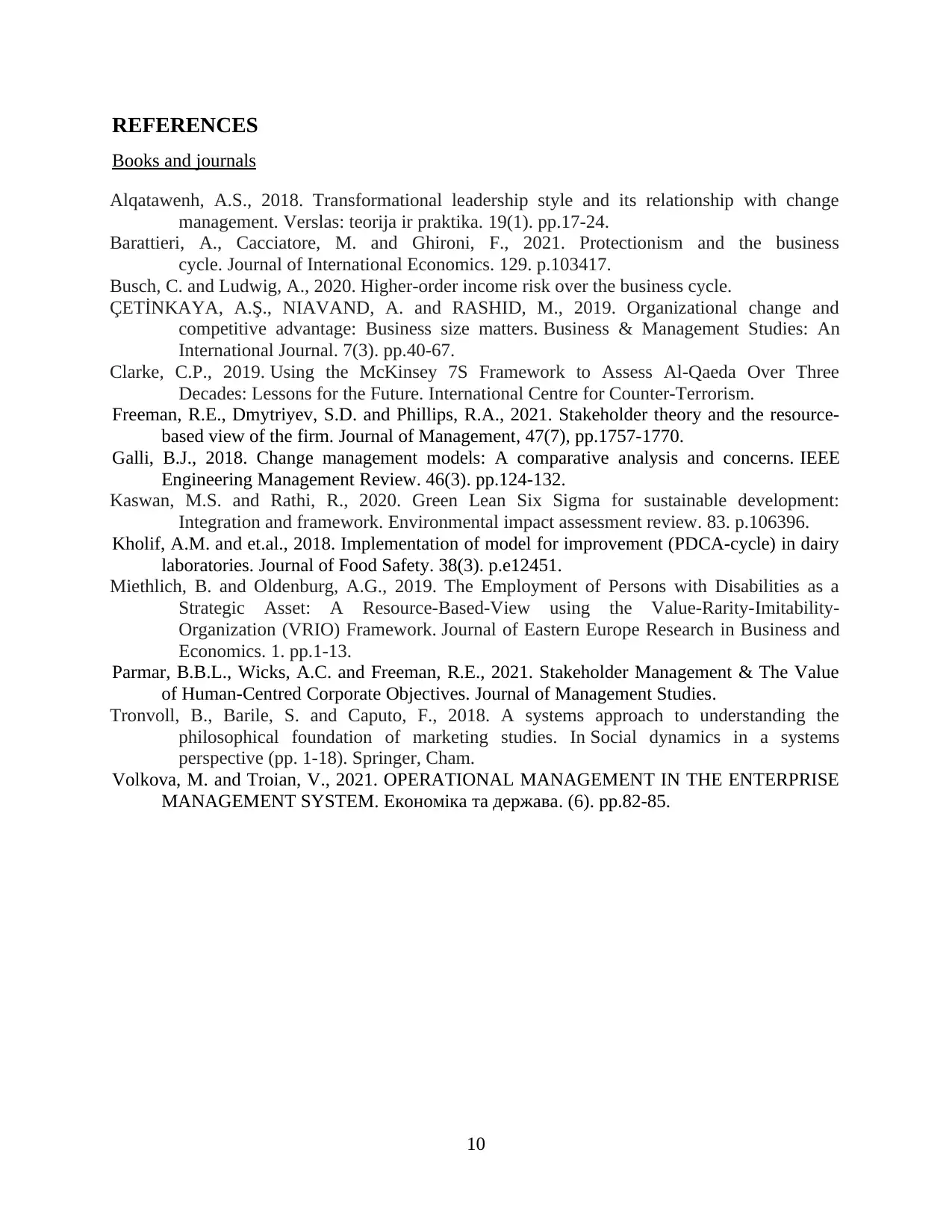
REFERENCES
Books and journals
Alqatawenh, A.S., 2018. Transformational leadership style and its relationship with change
management. Verslas: teorija ir praktika. 19(1). pp.17-24.
Barattieri, A., Cacciatore, M. and Ghironi, F., 2021. Protectionism and the business
cycle. Journal of International Economics. 129. p.103417.
Busch, C. and Ludwig, A., 2020. Higher-order income risk over the business cycle.
ÇETİNKAYA, A.Ş., NIAVAND, A. and RASHID, M., 2019. Organizational change and
competitive advantage: Business size matters. Business & Management Studies: An
International Journal. 7(3). pp.40-67.
Clarke, C.P., 2019. Using the McKinsey 7S Framework to Assess Al-Qaeda Over Three
Decades: Lessons for the Future. International Centre for Counter-Terrorism.
Freeman, R.E., Dmytriyev, S.D. and Phillips, R.A., 2021. Stakeholder theory and the resource-
based view of the firm. Journal of Management, 47(7), pp.1757-1770.
Galli, B.J., 2018. Change management models: A comparative analysis and concerns. IEEE
Engineering Management Review. 46(3). pp.124-132.
Kaswan, M.S. and Rathi, R., 2020. Green Lean Six Sigma for sustainable development:
Integration and framework. Environmental impact assessment review. 83. p.106396.
Kholif, A.M. and et.al., 2018. Implementation of model for improvement (PDCA‐cycle) in dairy
laboratories. Journal of Food Safety. 38(3). p.e12451.
Miethlich, B. and Oldenburg, A.G., 2019. The Employment of Persons with Disabilities as a
Strategic Asset: A Resource-Based-View using the Value-Rarity-Imitability-
Organization (VRIO) Framework. Journal of Eastern Europe Research in Business and
Economics. 1. pp.1-13.
Parmar, B.B.L., Wicks, A.C. and Freeman, R.E., 2021. Stakeholder Management & The Value
of Human‐Centred Corporate Objectives. Journal of Management Studies.
Tronvoll, B., Barile, S. and Caputo, F., 2018. A systems approach to understanding the
philosophical foundation of marketing studies. In Social dynamics in a systems
perspective (pp. 1-18). Springer, Cham.
Volkova, M. and Troian, V., 2021. OPERATIONAL MANAGEMENT IN THE ENTERPRISE
MANAGEMENT SYSTEM. Економіка та держава. (6). pp.82-85.
10
Books and journals
Alqatawenh, A.S., 2018. Transformational leadership style and its relationship with change
management. Verslas: teorija ir praktika. 19(1). pp.17-24.
Barattieri, A., Cacciatore, M. and Ghironi, F., 2021. Protectionism and the business
cycle. Journal of International Economics. 129. p.103417.
Busch, C. and Ludwig, A., 2020. Higher-order income risk over the business cycle.
ÇETİNKAYA, A.Ş., NIAVAND, A. and RASHID, M., 2019. Organizational change and
competitive advantage: Business size matters. Business & Management Studies: An
International Journal. 7(3). pp.40-67.
Clarke, C.P., 2019. Using the McKinsey 7S Framework to Assess Al-Qaeda Over Three
Decades: Lessons for the Future. International Centre for Counter-Terrorism.
Freeman, R.E., Dmytriyev, S.D. and Phillips, R.A., 2021. Stakeholder theory and the resource-
based view of the firm. Journal of Management, 47(7), pp.1757-1770.
Galli, B.J., 2018. Change management models: A comparative analysis and concerns. IEEE
Engineering Management Review. 46(3). pp.124-132.
Kaswan, M.S. and Rathi, R., 2020. Green Lean Six Sigma for sustainable development:
Integration and framework. Environmental impact assessment review. 83. p.106396.
Kholif, A.M. and et.al., 2018. Implementation of model for improvement (PDCA‐cycle) in dairy
laboratories. Journal of Food Safety. 38(3). p.e12451.
Miethlich, B. and Oldenburg, A.G., 2019. The Employment of Persons with Disabilities as a
Strategic Asset: A Resource-Based-View using the Value-Rarity-Imitability-
Organization (VRIO) Framework. Journal of Eastern Europe Research in Business and
Economics. 1. pp.1-13.
Parmar, B.B.L., Wicks, A.C. and Freeman, R.E., 2021. Stakeholder Management & The Value
of Human‐Centred Corporate Objectives. Journal of Management Studies.
Tronvoll, B., Barile, S. and Caputo, F., 2018. A systems approach to understanding the
philosophical foundation of marketing studies. In Social dynamics in a systems
perspective (pp. 1-18). Springer, Cham.
Volkova, M. and Troian, V., 2021. OPERATIONAL MANAGEMENT IN THE ENTERPRISE
MANAGEMENT SYSTEM. Економіка та держава. (6). pp.82-85.
10
Paraphrase This Document
Need a fresh take? Get an instant paraphrase of this document with our AI Paraphraser

11
1 out of 11
Related Documents
Your All-in-One AI-Powered Toolkit for Academic Success.
+13062052269
info@desklib.com
Available 24*7 on WhatsApp / Email
![[object Object]](/_next/static/media/star-bottom.7253800d.svg)
Unlock your academic potential
Copyright © 2020–2025 A2Z Services. All Rights Reserved. Developed and managed by ZUCOL.





